Campaigns
Working to improve the built and natural environment of Portsmouth for 50 years.
The Portsmouth Society is an independent voluntary body affiliated to the Civic Voice with the purpose of promoting good design in the built environment. We campaign for quality in new buildings and for the preservation of the best of Portsmouth's existing environment of buildings, streets, open spaces, harbour and seashore and to encourage design excellence in new buildings and urban spaces." www.portsmouthsociety.org.uk. Since 1983 the Society has run Best Design Awards: Best New Building, Best Restoration, Best Re–use and Best Landscaping. To nominate an entry contact the Portsmouth Society.
In 1976 Celia Clark was a founder member of the Hampshire Buildings Preservation Trust. The Trust was formed by Hampshire County Council as part of its response to European Architectural Heritage Year in 1976. Its principal objective was to increase public awareness of the plight of those historic buildings which were suffering from either a lack of maintenance or lack of a viable use. weblink. She is still an active member of the board, working closley with the Portsmouth Society on campaigns such as St Mary's House, the Theatre Royal and Wymering Manor. The society contributes an account of each year's work to the trust annual report.
Portsmouth Society Civic Award 16 May 2023
The Portsmouth Society is delighted to receive a Civic Award in this, its 50th Anniversary Year. As local people who live here, work in and enjoy the city, we've been playing an active part in shaping its built and natural environment since 1973. As a member of the city planning committee, the Lord Mayor praised our well-considered comments on planning applications, even if he didn't always agree with them! Our Annual Design Awards help to raise the standard of sustainable architectural design of new and converted buildings and landscaping. The Lady Mayoress told us how important voluntary organisations like ours are to the quality of local life.
See https://youtu.be/oAGzZr9NsMI
When we formed in 1973 Portsmouth had been drastically reshaped by 'Comprehensive Redevelopment' which led to large scale demolition of much of Buckland, Somerstown and Portsea - and many historic buildings were lost. Major roads were ploughed through the city fabric, including Winston Churchill Avenue, part of the proposed East-West Road, which sliced Somerstown in half - and the North-South Road which led to the loss of most of the buildings in old Commercial Road. The beautiful Lady Chapel of St. Agatha's Church was demolished by Market Way. We and the vicar of Stamshaw resisted the original route of the M275 through Stamshaw, so instead the UK's shortest motorway was built on a new causeway in the harbour between Whale Island and the Stamshaw shore, using chalk from Portsdown Hill. The white scars on the hill are still visible. Land reclamation in Wymering created a new shoreline, where the IBM headquarters were subsequently built.
The city centre was redrawn in a new square and civic offices. Lord Esher's plan was so drastic, a leaflet asked 'Where's our Guildhall?' By 1970 the Conservation Movement was just getting started and Portsmouth was quick off the mark. Two Historic Buildings Architects, Deane Clark and Brian Young were appointed by the city to designate 19 conservation areas, to restore Southsea Castle and to convert Clarence Barracks to the city museum. Brian Young suggested that we form a local conservation group, so we founded the Society in 1973 in John Goodall's flat in Kent Road Southsea. We decided to affiliate to the Civic Trust as our parent body since our focus was to be the city's built as well as natural environment, and on public participation in planning.
Our planning committee continues to comment on planning applications affecting historic buildings and major planning proposals. Since Portsmouth is so short of open space, our Trees and Streets committee spent months listing all the street trees in the city, which could then be protected by Tree Preservation Orders. We set up the Somerstown Community Garden and the city's Tree Wardens.
We've saved key buildings to active new uses, sometimes making the case for them at public enquiries, allying with other groups such as the Hampshire Buildings Preservation Trust, or setting up new bodies to take on their restoration and reuse directly. St. Mary's House, built in 1846 as the city's old workhouse for homeless, workless people was the biggest building we saved from demolition. The planning inspector was impressed by its educational value. Portsmouth Housing Association converted it into flats. Rivers Street Hall in Somerstown won the national £2000 SAVE Britain's Heritage Award in 1977 which was used by the Somerstown Community Association to restore it as a small theatre venue. Now it's been converted into three houses. We saved the Theatre Royal, the Palace Cinema (now Astoria), the Dog & Duck in Fratton Road - now a nursery, the dockyard Cell Block and Boathouse 4, the Beneficial School - now the Groundlings Theatre in Kent Street Portsea, the Vulcan building in Gunwharf - now flats and the Aspex Gallery. Portsmouth Society members are trustees of Wymering Manor and the Omega Centre in Somerstown.
We look forward to continuing to play our active part in conserving and enhancing Portsmouth's special built and natural environment - as we've done in the last 50 years.
Contact Graham Newcombe /Celia Clark 02392 732912
Celebrating Portsmouth's Inspirational Women Activists
Celebrating Portsmouth's Inspirational Women Activists
Southsea Seafront Campaign

Flooding on Southsea Common by Storm Roger landward of Portsmouth War Memorial March 2020
Link to Facebook page: SouthseaSeafrontAtRisk/
Sea Defences Exhibition Southsea Tennis Club 24/25 February 2023
"It almost felt as if the meeting was just an exhibition rather than a consultation, schemed purely as a release for public frustration ... and that they were going to do afterwards, what they had always been planning to do ..."
There were engineers, archaeologists, historians and cultural policy people there to ask questions of, so we learnt a lot. BUT – it was all top-down, them telling us things, with no response forms – or opportunity for us to register our responses. Dots on a map indicating where we came from were all that they recorded. As there are two current planning applications for Frontage 5 we might have expected that responses to those designs would have been at the very least invited.
Again and again if I asked a question, they would say you have to speak to X ... but X didn't know the answer either. A cohesive team clearly does not exist, which is poor management considering the huge investment in the scheme: approx. £100m by the government.
First we spoke to archaeologists of Wessex Archaeology about what they have discovered – in Old Portsmouth and the eastern part of Southsea Castle's fortifications. They have 15,000 photos, record drawings and written records. We were shown the drawings of what was discovered at Spur Redoubt where other jetties and walls were uncovered – which are now reburied. A curved wall of a gun emplacement from the 1860s was discovered at the top of the eastern outer wall of Southsea Castle, and they also found a triangular bastion by De Gomme made of limestone from the IOW to seaward of that. The curved concrete walls around the castle have now been modified to incorporate the bastion in a triangular projection, but the wall itself will be reburied beneath. Further east was a wall of regular stone blocks which had been robbed for other structures. I asked when the Archaeological Report was to be published. They said to ask Wessex Archaeology.
I asked an engineer why the metal used in the seagates in Long Curtain Moat were already rusting. He said "What other metal should they use?" We aren't the only ones who spotted that in the new work: the rusty screws are already decaying. The answer is stainless steel. This was passed on to Rena who is responsible for public liaison.
The first time we heard the landscape architect from LDA speak, her proposals were very dull – as is now apparent ... I asked why the design of the Old Portsmouth section is so dull. We were told that Iain Bright of Historic England stipulated that the design emphasis in Frontage 1 should be the Monument – to speak for itself. So furniture and light columns were kept simple ... The lights are just buckets hung on poles. They described them as light columns holding lights with different functions. The dull ground surfaces of coloured concrete were apparently what HE wanted. I asked about the dump patches. They said that they may have to alter the levels of the concrete slabs, which had been set too high. Interpretation boards were being made, with wording being worked on by the city museum – with HE's input. There was no clear answer about when they would be installed.
Frontage 5 to the east of Southsea Castle opposite Southsea Rock Gardens, which they are now starting work on was different from Old Portsmouth: the Edwardian lamp standards would be taken down, refurbished and reinstalled with modern lights. They were still working out how to replicate the festoon lights between them. This section and the area opposite Common are to have concrete steps like those they've already built in front of the castle, I asked where building concrete steps and then covering them with shingle had worked elsewhere, and was told at Dymchurch ... The beach is part of the flood defence. We had a discussion about the failure of the concrete steps at Blackpool which were undermined from below. It was a bigger sandy beach which was not 'managed'. Lessons had been learned from Blackpool, which we agreed had a higher tidal range. All beaches change. Groynes are used at Hayling.
A key discovery, which we had already heard at the Stakeholders' meeting on 16 February, was that the Arts package was taken out from the scheme and made a separate project. Steve Pitt told us then that he had £3/4m in the pot for arts spending. I spoke to Claire Looney who is charge of this aspect, advising PCC. I said that artistic input should have been integral to the design from the outset – or some of the engineers' work might have to be dug up and replaced. Not to include the surface we all walk on in the design is absurd – and point up just how counterproductive divorcing the arts input is from the engineering. The 'Grecian fret' designed by Ken Norrish has been there for more than 50 years ...
Claire was drafting a framework for a Seafront Arts Programme Officer, an administrator (not an artist) to oversee the arts input to the engineers' work. They were recruiting now for Arts Council funding, for a collaboration between experienced artists and artists with no experience in public art, as a way of building the creative industry sector in the arts in the city. The person (who would not be an artist) appointed would have a varied brief. Some sites would involve collaborative work, some would be bespoke, some would involve proposals to fill a blank space – as in the 4th plinth. West Cumbria was a new artist–led scheme. I asked how the rescued stone from Old Portsmouth was being used. Some was used in Copnor but there's enough to invite its reuse in public art features. I asked if local architects, landscape architects, design and architecture students would be involved. Could there be design competitions? She said there might be for the replacement eastern shelter beyond the Briny. The Manchester consultancy had produced all those public art ideas for us to see, but there was no commitment to implement any of them, or any of the 20 artists' designs for the seafront exhibited at the D–Day museum.
The Start of the Campaign
In summer 2017 Portsmouth residents were concerned that the East Solent Coastal Partnership's design to defend Southsea seafront from rising sea levels and storm surges would create a rampart up to 3.8m high from Clarence Pier to Eastney and replace the beach with concrete steps – as at Cleveley Blackpool – picture below. Portsmouth island produced a research report based on experience in Holland – picture below – which demonstrated that a 'soft engineering' design with three lines of defence: the beach, mounding on Southsea Common and a dike would be more effective, as well as not destroying the beach. Local people have formed a group: Defend Southsea Seafront, which held its first public meeting on 25 November 2017. We have asked to be directly involved in the design by contributing our local knowledge and expertise – before it is set in concrete! Our petition has already reached over 3,700 signatures, at least 1400 of them Portsmouth residents. Follow us on Facebook!
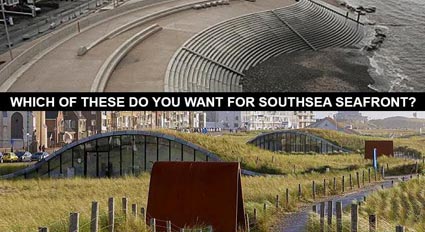
Petitioning Portsmouth City Council and 1 other.
Give residents a better choice of flood defence proposals for Southsea seafront.
Portsmouth Resident Portsmouth, United Kingdom.
Southsea needs new sea defences to protect us from storms and rising sea levels – without a doubt! We've all seen what they can do to the seafront.
Portsmouth City Council's current proposals are to create a stepped concrete rampart, up to 3.8m high, mostly replacing the beach, from the Hot Walls to Eastney.
They have now confirmed that all future public 'consultation' will only offer us one choice: their 'strategic approach' – which does not take account of the damage losing the beach will do to local businesses and local residents' and tourists' enjoyment of the seafront.
The government will fund new sea defences, but they recommend that different approaches are developed, fully considered and consulted on before funding is paid out.
There is an alternative soft engineering design for Southsea based on extensive research, and on experience from Holland.
This 'soft' approach has many advantages. Instead of just the concrete wall or ramp, there would be three lines of defence: the beach, mounding and a dyke, with car parking and other amenities constructed underneath the mound – which need not be made of sand. We will have new sea views, and current parking areas can be greened over.
This design has not been considered by the city council. Yet it has real advantages - as we have the space on Southsea Common to consider other options - thanks to the Ministry of Defence stopping houses being built right up to the shoreline.
We believe the current hard engineering solution, using concrete to create flood defences like the hard steps to the seafront at Cleveleys in Blackpool, will do serious damage to the future prosperity of Portsmouth and Southsea. As an island city Portsmouth's sea defences could lead the country in excellence of design and function.
For comparability, we ask Portsmouth City Council to give equal weight to soft engineered solutions for our sea defences, so that at the 'Consultation' stage we have genuine alternatives to consider.
Portsmouth City Council Eastern Solent Coastal Partnership
NatWest Bank Palmerston Road/Osborne Road Southsea
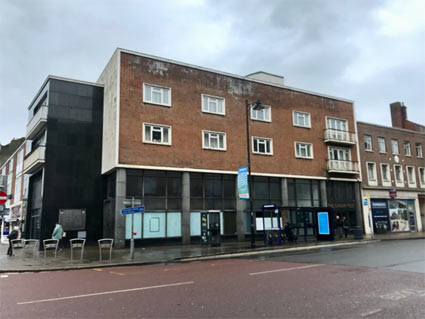
We've applied to Historic England to list this postwar bank. It closed in February 2023
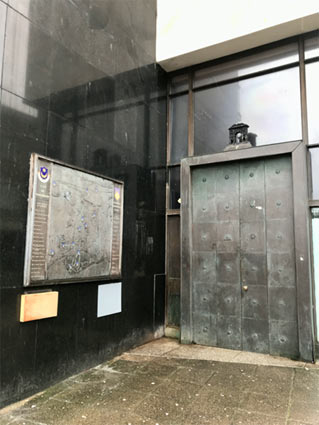
Bronze City Map and monumental entrance doors

Dancing mermaid in the banking hall
Saving Buildings In Portsmouth
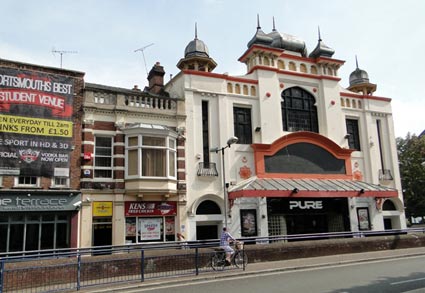
The Palace Cinema
The former Palace Cinema with its zinc domes and facade in Indian Moghul style was designed by AE Cogswell in 1920–21, after he had served in the Artists' Rifles at the Khyber Pass. In the early 1970s, it was to be demolished and replaced by a spanning block across Guildhall Walk for the completion of Lord Esher's plan for a 'civic island'. Celia Clark as Secretary of the Portsmouth Society appeared at the public inquiry with support from EMI and Dennis Sharp, the cinema historian, making a successful case for keeping this oddity in the city centre. It was listed grade II in 2000, and is now a night club.
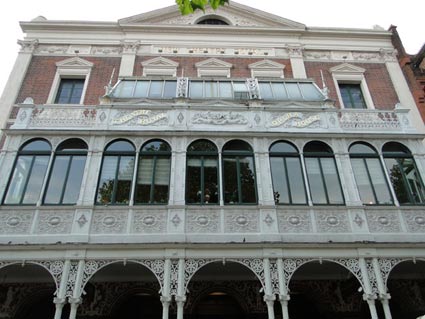
The New Theatre Royal in Guildhall Walk
Portsmouth City Centre developed from the Landport Hall of 1854, reopening as the New Theatre Royal in 1856. It was rebuilt in 1884 to the design of C J Phipps, architect of several London theatres. In 1900 the famous theatre architect Frank Matcham reconstructed the interior and the street facade. The Theatre Royal was under threat of demolition for many years. The Theatre Royal Society and the Portsmouth Society campaigned to keep and restore it. The Hampshire Buildings Preservation Trust restored the metal balcony and several phases of restoration and modernisation are bringing the theatre back into vibrant use. In 2015 a new studio theatre and rehearsal spaces are under construction.
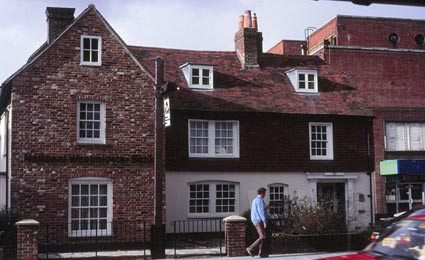
Dog and Duck pub in Fratton Road
The seventeeth century cottage which became the Dog and Duck pub in Fratton Road was under threat of demolition. The Hampshire Buildings Preservation Trust worked with a local developer to remove the nineteenth century pub front and restore the building. NatWest bank occupied it. Now it is a nursery school.
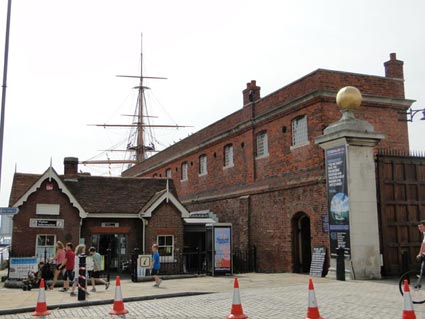
1880s Cell Block
This 1880s Cell Block – for people arrested inside the dockyard – lost the staircase to the upper floors when Main/Victory Gate was widened in WWII. When the building broke its back from piling for the Warrior berth, it was under threat of demolition. The Society campaigned for its group value with the Recruitment Office, and there are plans for its restoration and conversion by Portsmouth Naval Base Property Trust. In 2005 the University of Portsmouth converted it to start up spaces.
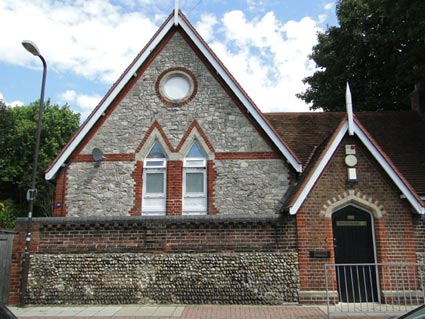
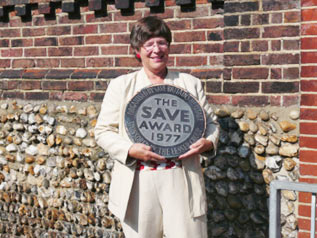
Rivers Street Hall, Somerstown, Portsmouth
This delightful little church school was built by George Absolom in 1868 for the poor children of St. Peter's Parish. It was paid for by the wealthier congregation of St. Jude's has Portland stone in its walls which may have come from the town walls, which were being destroyed at that time – for expansion of the town. ??In the mid 1970s the hall was empty and decaying, but its coursed pebble walls and gabled Gothic tiled roof and the two halls inside attracted Hurst Rinehart – who is a clown, PALFI – for its potential as a small theatre arts space. A small group including Tim Smith of Tipton House and Celia Clark formed the Somers Town Community Association to save it.??Because we had no financial resources, we had to turn ourselves into employers and run a youth employment programme to repair it. Our efforts were so considerable that in 1977 we won the national SAVE Award, sponsored by the Lesser Group – the only time it was ever awarded: a £2000 cheque and a large inscribed slab of slate. Since then, it has been used as a children's art club, old people's lunch club, playgroup, Catholic church using Latin for services, architects' studio. A housing association recently converted it into two houses.
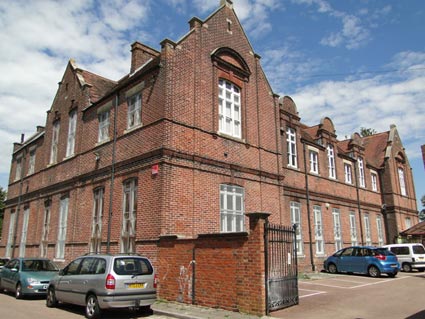
Omega Street School Somerstown
The former Omega Street School of 1881 designed by A H Ford for the Portsmouth School Board was under threat of demolition in the 1980s. The Portsmouth Society campaigned to save it, and it was restored, and the Omega-shaped garden and a lift were added by Hampshire County Council.
It has had many recent uses: WEA, adult education, nursery, church, mosque, drama studio, university furniture design and decoration and restoration courses teaching space. The Restoration and Decorative Studies students learnt specialist techniques including faux finishes, scagliola, gilding and plasterwork, the history of architecture and building conservation there until 2008 when the course closed. Graduates went on to work at Windsor Castle and Up Park.
The main building is now occupied by a popular boxing academy, fully equipped ceramics studio, professional printmakers workshop, Omega Centre Art School and Pompey Pirates helping children's literacy, and the Southsea Shakespeare Actors use the former primary school building at the back as their rehearsal space and scenery construction workshop.
The Omega Centre Trust, a registered charity was formed in 2022 with encouragement from Cllr. Gerald Vernon Jackson, the then leader of the city council, to manage and eventually take on ownership of the building from the Portsmouth City Council Elementary Education Foundation. This charity consists of three city councillors including Cllr Vernon Jackson. The city council paid for our draft business plan, which included repairing the building - which is basically sound but has had little maintenance in recent years, so work is needed on the roof, window frames, tackling the causes of buddleia growth and security systems. We plan to set up training courses to teach these skills, which would bring costs down and attract funding.
Delay after delay meant we received no clear answer to our bid. Exaggerating repair costs is a well-known tactic justifying pulling down existing buildings, to say nothing of wasting their embodied energy ... The threat to the building is the charity's likely proposal to transfer ownership to the education department, pull it down and build a special needs secondary school on the site.
"Long life, Loose fit" buildings like this have mostly disappeared. The boxers and literacy groups have existing leases, and where the other current users would go is not discussed. The building is not listed, but there is space for more local groups to use it for the benefit of local people in a deprived part of the city.
January 2024
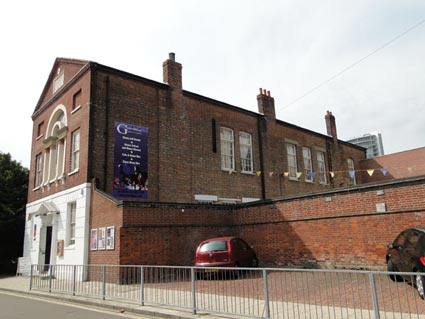
The Beneficial School
The Beneficial Society, an early mutual benefit society, built the Beneficial School in 1785 for the education of poor children. Designed for monotorial teaching, it is one of the oldest charity schools in the country, listed Grade II*. The Assembly Room on the first floor was the setting for many great occasions, including concerts by Niccolo Paganini. Charles Dickens's mother attended a concert there the night before his birth in 1812. The school continued in use until 1960, when the adjoining replacement was built. The Beneficial School's future was uncertain for many years. Uses for adult training did not last, but in 2010 the Groundlings Theatre Company reopened it as a community theatre.
Portsmouth School Board Buildings
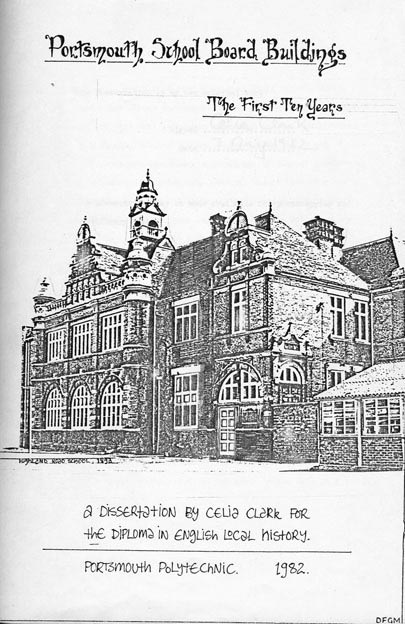
This study of Portsmouth School Board's first ten schools was based on the extensive documents in the City Records Office, and the surviving School Board buildings.

Celia Clark has a special interest in school buildings. Her report Beacons of Learning: Breathing new life into old schools published in 1995 by SAVE Britain's Heritage draws attention to the potential of old school buildings, particularly those in urban areas in England and Wales, for creative and beneficial reuse once they are no longer needed for teaching children. Essays on the evolution of school design by Roy Lowe, Andrew Saint, Malcolm Seaborne, Robert Dark and Elizabeth Hunter are related to contemporary educational theory. Edith Gollnast describes the conversion of village schools and Michael Morris the upgrading and extension of Victorian schools in Hampshire. Many varied case studies then examine experience of new uses in more detail. The report was sponsored by English Heritage & Hampshire County Council. 205pp.
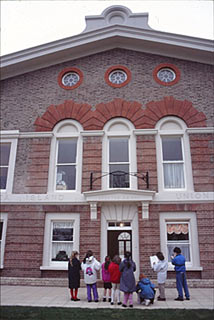
St Mary's House, the former Portsea Island Union Workhouse of 1845 designed by Augustus Livesay and Thomas Ellis Owen for a thousand paupers was under threat of demolition. The modern St. Mary's Hospital developed to the south, and the workhouse was ued to house old ladies. Hampshire Buildings Preservation Trust, Hampshire County Council and the Portsmouth Society made a successful case for reuse. Portsmouth Housing Association converted it into modern flats, so once again homeless people live there as tenants or as shared owners.

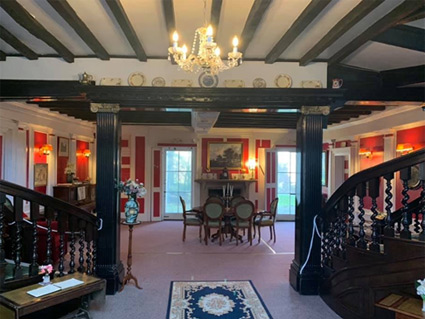
Wymering Manor, the Grade II* listed historic house in Wymering, Cosham, whose timber frame dates from 1581, has a long and interesting history. It was built by the Catholic De Bruning family, and its Elizabethan timber frame wraps round the great hall with its dramatic twisting staircases to the fine rooms and attics above, while the nineteenth century extensions housed a religious community linked to St. Peter & St. Paul church opposite. When it was under threat of demolition in 1959 Portsmouth City Council purchased the manor. It served as the city's youth hostel from 1960 until 2006 when the YHA moved out because the decaying timber frame had not been repaired so rooms the north wing could no longer be used. The Friends of Old Wymering formed in 2006 by nearby residents and historians organised Open Days, guided tours, educational events and maintenance of the garden to show people of the city the treasure in their midst. With the Portsmouth Society and Hampshire Buildings Preservation Trust the FOW urged the city council to seek alternative uses to bring the manor back to life. Local developer Ian Young was granted planning permission and listed building consent to convert it into a historic hotel, but the city failed to agree terms of a license with him. There were several failed attempts to sell it at auction.
In 2013 the Wymering Manor Trust was set up and given the manor by the city; Celia Clark is one of the trustees. Our aim is to restore, convert and build a sustainable future for the manor for local people to enjoy as their 'home from home', as we manage the building to earn its keep by letting rooms for events, meetings, education and training, putting on plays, ghost hunting, socialising and new activities. The National Heritage Lottery Fund paid consultants via a Resilience grant to produce specialised plans to help the trustees plan its future, including substantial fundraising. Once restored, the manor will be a centre for the local community and a catalyst for regeneration of this deserving area of the city, offering people help in wellbeing, tackling loneliness and isolation, developing personal skills and bringing the community together to shape its future. We're on track to raise the £5.9m we need with the application to the final stage of lottery funding and matched fundraising. Key areas for the trustees are: developing our forward plans, strategy development and maintaining our financial viability. If you would like to join the trustees, please apply via email to applications@wymeringmanortrust.org.uk. We also welcome volunteers who enjoy maintaining the house, gardening, organising special events and Open Days. Apply to our Volunteer Coordinator: annmarie.ridgway@wymeringmanortrust.org.uk

The Vulcan Storehouse of 1814 has a functional elegance, celebrated in Henry Slight's poem which describes Gunwharf as 'sacred to utility'. After it ceased in active use in the 1950s, it deteriorated for many years; the beam ends rotting. Celia Clark and Roger James of the Portsmouth Society saw its wonderful spaces had potential as an art gallery. The City Arts Administrator thought so too, and national galleries were approached. However developers Berkeley Homes were given planning permission to convert most of it into flats, but the local Aspex Gallery moved into the ground floor of the south wing. Their conversion by Glen Howells Architects has justly won several awards.
Lost Buildings

The Tricorn has been celebrated – and reviled – in festivals, ballet, music, performance art, videos, websites, films, virtual fly-throughs, poetry, books, television and radio. How many other buildings have inspired such an efflorescence? Despite its demolition, it still lives vividly in people's memories and dreams. Celia Clark and Robert Cook explore what makes an architectural icon – and what unmade it. This book sets the Tricorn within its architectural context: Brutalism and the 1960s. The unpopularity of Brutalism and the fact it was a commercial property affected the Tricorn's fate. The book draws on two sources not usually combined: a collage of documentary material, and the rich seam of people's descriptions of life in the building. The Tricorn's architects: Owen Luder and Rodney Gordon explain the building's genesis and reflect on its demise. The 1812 Overture was played at its demolition - a reflection of the Tricorn's heroic status in people's imagination.
Copies available from Celia Clark directly £18.50 plus £5 PP
The Tricorn has been celebrated – and reviled – in festivals, ballet, music, performance art, videos, websites, films, virtual fly–throughs, poetry, books, television and radio. How many other buildings have inspired such an efflorescence? Despite its demolition, it still lives vividly in people's memories and dreams.

Pitt Street, Pitt Street Baths
The Portsmouth Society campaigned to save this building, the Royal Naval School of Physical Training 1910, used as a regional centre for Gymnastics, but Portsmouth City Council pulled it down. The site is still empty, years later.
World Heritage Site

Portsmouth Harbour, the Isle of Wight and Spithead. The world's first Cultural Seascape to be inscribed on the World Heritage List?
Bid Cancelled 2006. Still a good idea!
Greening the Grey Tricorn Site
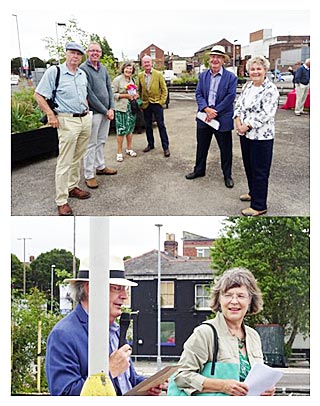
There are four inspirations to this scheme.
1. As Secretary and Chair of the Portsmouth Society Roger James and I attended the Greening the Towns and Cities conference held in Liverpool in 1984 in association with the Liverpool Garden Festival which created a temporary park along the banks of the Mersey.
We heard from inspirational speakers all over the world, including how the fortunes of Prospect Park in Brooklyn New York were completely turned around. The Park had been designed by Frederick Olmstead who was inspired by the first public park - Birkenhead Park on the northwest of England - to design Central Park as well as Prospect Park. The Warden described how she and volunteers had completely transformed a dangerous space haunted by drug dealers and criminals into a marvellous resource for the city of New York, much loved and enjoyed by locals including our daughter and her family who live in Brooklyn.
2. Roger and I came back to Portsmouth from Liverpool inspired to green a bit of Portsmouth, and a couple of years later the city council gave us a bit of space left over after planning in Somers Town where Roger worked as a doctor – on the south side of Winston Churchill Avenue to create Portsmouth's first Community Wildlife Garden. It's still there – a little haven of quiet peace, and it's recently been joined by the Somerstown Community Garden in the grounds of the Omega Centre where local people can grow fruit and vegetables. The lovely Stacey Garden and Orchard in Copnor is another special space gardened by locals.
3. I picked up the Greening the Grey idea several years ago from walking round Islington near the Emirates stadium – that empty sites hit by the recession should be greened on a temporary basis, until developers are ready to build on them. You may remember the community garden in the heart of Covent Garden.
4. The Royal Horticultural Society currently has a Greening Grey Britain campaign – encouraging us all to create green spaces in our cities – so you could say it is an idea whose time has come!
Why green the Tricorn site? Members of the Portsmouth Society and a City Council officer met on the site in April 2011 and agreed on why we want to green this site. As a main road entry point to the city centre, the bare expanse of carpark does not give the impression of a vibrant, innovative, well designed approach for visitors to the Historic Dockyard, shoppers, university students' parents ... not to mention how it feels to Portsmouth residents. Ben Ainslie's Americas Cup was the final push which made it happen.
There is currently a gap on the south side of Market Way in the 'green corridor' which otherwise extends on the north side from the new landscaping in Mile End by the Highways Agency to St. Agatha's park. Facing the Tricorn site are eight plane trees and bushes bordering the Pitt Street carpark, maintained by the city council. Ivies are growing well in the central barrier of the road.
Portsmouth as a city is seriously lacking in greenspace. This project is intended to bring visual benefit - a green link - to a grey, desertlike area. The first design in 2011 was by Architect Carl Leroy-Smith, but it's taken all this time to get the current scheme together and raise money to implement it. It's only due to the persistence of David Baynes and his fund raising skills that this project being launched today has materialized. As far as we know, it is the first temporary greening of a recession-hit site in the south of England – and there's a two stage benefit to the city, because once development finally gets under way on the site – which has already been empty for 11 years, the plants will be moved to enhance the city parks and green spaces.
We are very fortunate to have brilliant city officers in Portsmouth – including Barry Walker, the City Centre Manager and Vincent Mount, senior Landscape Architect who designed the beautiful and award winning central reservation in Commercial Road inspired by Southsea Beach. These two made our idea bloom – with sponsorship from the city council, Portsmouth Tree Wardens and Sir Nigel Gosling's Trust. Barry Walker raised sponsorship for Vincent to design the planting and containers, the Hampshire Gardens Trust supported the idea, and the talented Shaw Trust members constructed and planted them.
